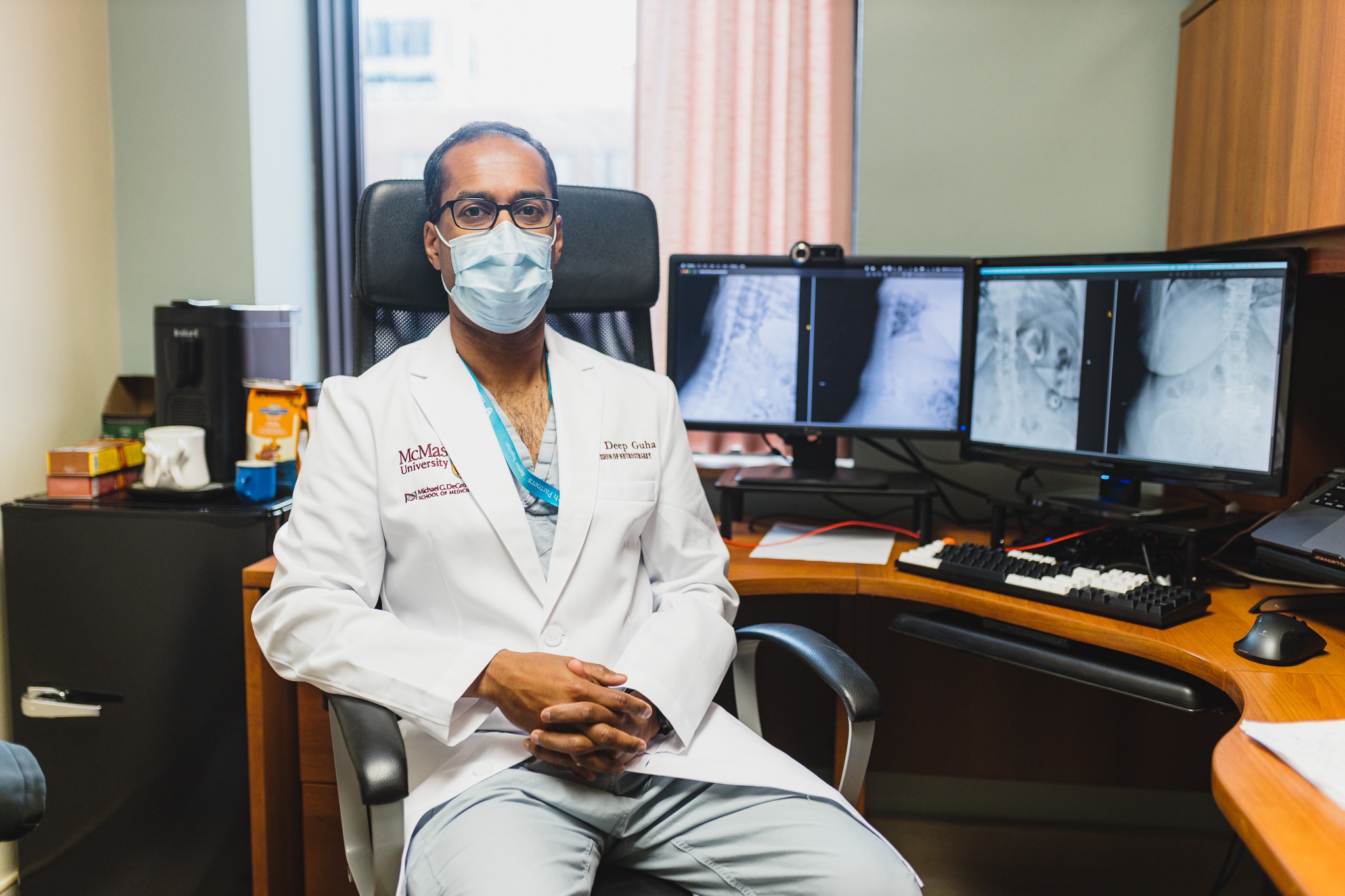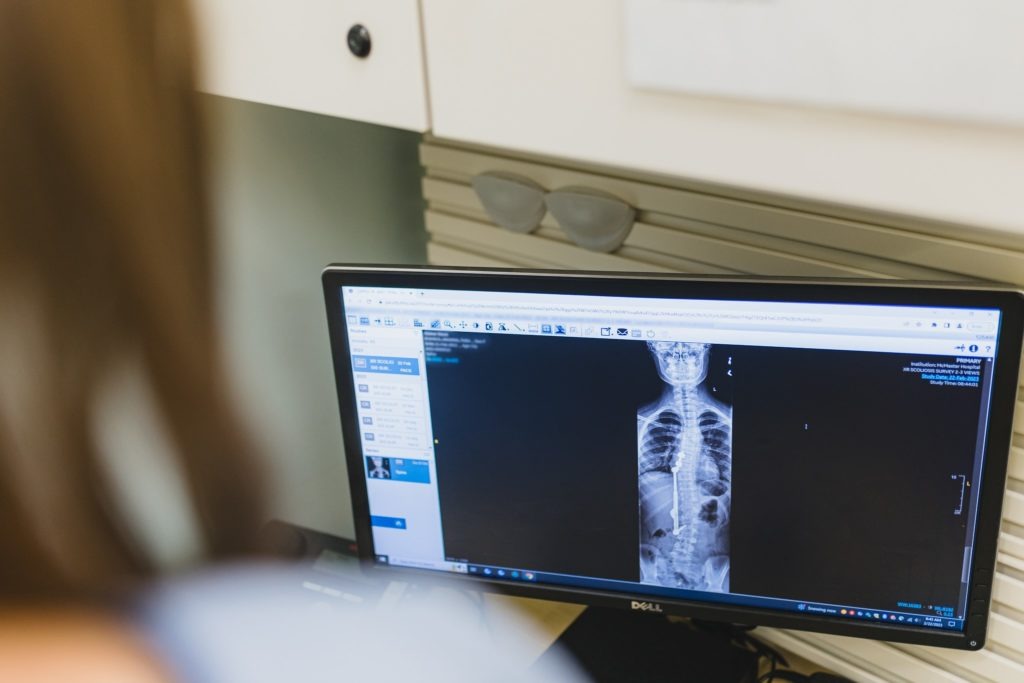
New scoliosis surgery option quickly puts young patients back on their feet
A new approach to surgery for some young scoliosis patients means a shorter recovery and more mobility to get back to regular activities faster.
Scoliosis is a sideways curvature of the spine that is most often diagnosed in adolescents. Untreated, it can lead to significant problems affecting breathing and heart function. To straighten the spine, surgical teams normally perform a spinal fusion operation to realign and fuse backbones together with rods and screws so that they heal into a single solid bone. Hamilton Health Sciences’ McMaster Children’s Hospital (MCH) teams perform around 40 operations a year to correct spines for adolescents and children. Last August, the MCH team treated an 11-year-old patient with a new, less invasive system called ApiFix.
“If you qualify, it truly is an amazing option for scoliosis,” says Chief of Pediatric Surgery, Dr. Devin Peterson. “We’re seeing a lot more patients that can qualify for this type of surgery.”
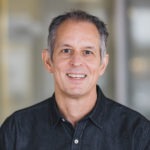
Dr. Devin Peterson, chief of pediatric surgery at McMaster Children’s Hospital.
Dr. Devin Peterson, chief of pediatric surgery, says that because of this patient’s type of scoliosis, and their age, this patient was the perfect first candidate for this new procedure. Benefits include shorter surgery, increased mobility, and easier recovery.
“Indications based on age, size of the curve, and flexibility of the curve are factors that determine whether or not ApiFix is a good route,” says Peterson. “Spinal curves that are up to 60 degrees with good flexibility and typically patients ages 10 to 14 are the criteria.”
“I am thrilled and excited to be able to perform this surgery at MCH – it’s a whole new level of scoliosis surgery, and will bring so many opportunities to kids,” he says. “I am so grateful to the hospital leadership and operating room team for making this happen and having faith in bringing this system to our hospital.”
Less hardware and more movement
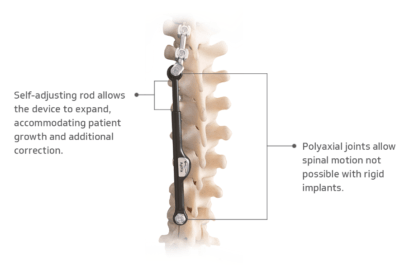
The ApiFix system uses a self-adjusting rod that acts as an internal brace to help straighten the spine.
ApiFix is known for preserving motion while achieving curve correction, without the permanence of fusion. It allows the spine to grow while also permitting movement. It has the ability to straighten the spine as much as possible with only three screws placed into the bone. In traditional fusion surgeries, surgeons use up to 20 or more screws.
Peterson recommended getting this system in MCH’s operating room once the family decided they wanted to go with ApiFix. “He was truly advocating for the best outcome, and a better process for my child,” says the patient’s mother.
“As a parent, you do your homework and educate yourself on everything before making a decision,” she says. “After doing research and working with Dr. Peterson, I was confident in his recommendation and felt that ApiFix would give my child the best results.”
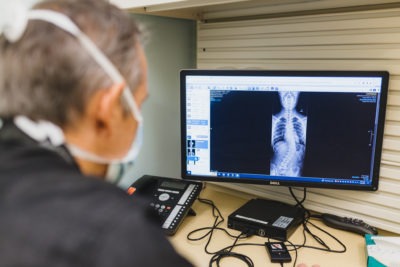
Patient x-ray showing curvature in spine before surgery.
Rather than a nine to ten-hour surgery, the operation takes three to four hours and is led by the operating room team along with ApiFix professionals.
“If you qualify, it truly is an amazing option for scoliosis,” says Peterson. “We’re seeing a lot more patients that can qualify for this type of surgery.”
The Children’s Hospital of Eastern Ontario in Ottawa and the IWK Health Centre in Halifax are the only other centres in Canada that offer this surgery. Dr. Peterson anticipates a higher volume of patients will be seen at MCH now that it is available here.
Faster recovery
Because this surgery is less invasive and takes less time, recovery is much faster than with fusion surgery. In the case of MCH’s 11-year-old patient, the patient was able to walk the day after surgery and was also able to return home the next day.
“The big thing is maintaining mobility. The difference is that movement is encouraged,” says Peterson.
Recovery from fusion surgery takes much longer, often requiring a hospital stay close to a week plus six weeks away from school. The patient shouldn’t bend, or move too much post-surgery and a physiotherapist works extensively with the patient in hospital to slowly get them back on their feet and back to everyday motion.
“This new system is going to be a game changer,” says the MCH patient’s mom. “It has shown a miraculous difference in corrective surgery, especially with recovery. Two hours after the surgery I was watching my kid walk around in the room.”
Peterson adds, “The big thing is maintaining mobility. The difference is that movement is encouraged. As you move, the spine can straighten more. Patients have more flexibility and are able to start the process of moving quicker.”
Even with the new procedure, patients don’t participate in advanced movement such as dance and sports for a number of months, until the screws settle in and adjust. However, they are able to return to activities much quicker than with fusion surgery. Post-surgery follow-up appointments start with a visit about two weeks after the operation, then every few weeks, then progressing to every couple of months.
Looking forward to skateboarding
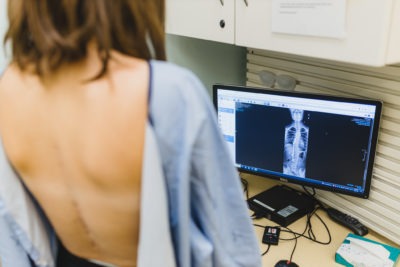
Post-surgery x-ray showing metal rod placed to correct curve in spine. Patient recovery has gone extremely well.
“This patient has done amazingly well,” says Peterson. “Their spinal curve was close to 60 degrees, and having this correctional surgery has lowered it. And this patient still has a lot of growing to do which will be accommodated by the new system.”
The patient is excited to get back to skateboarding after a couple more follow-up appointments, and riding the rollercoasters at Canada’s Wonderland.
“I would highly recommend other families who are faced with this to connect with Dr. Peterson and the team about this new innovative surgery,” says the patient’s mom. “Dr. Peterson is the most professional and knowledgeable physician we have worked with.”

